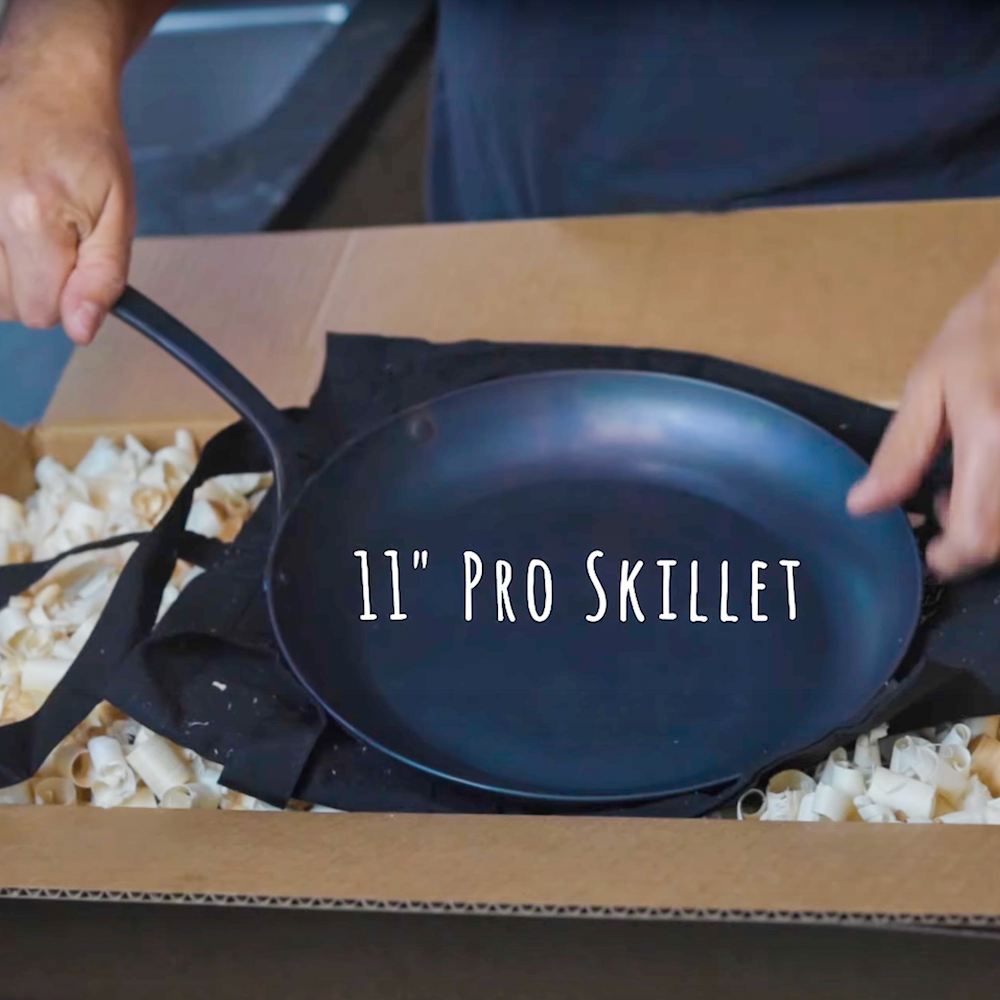What is Carbon Steel?
Carbon steel is an alloy made primarily of iron and carbon. While all steel contains carbon, “carbon steel” has a higher carbon content than stainless steel. This gives it great heat conduction—like cast iron—but it heats up and cools down more quickly and heats evenly. Blanc carbon steel has ~0.1% carbon—lighter and more responsive than cast iron. Unlike stainless steel, it doesn’t have rust-resistant metals like chromium or non-stick Teflon coating. It needs seasoning and care but excels at everything from searing and sautéing to baking and rendering fat. Carbon steel pans are great for cooking eggs, frying, sautéing, searing meat, baking, and rendering fat.
Advantages of Carbon Steel
Why Chefs Love Carbon Steel Pans
- Natural Non-Stick Surface: Develops a slick patina over time with no synthetic coatings.
- Non-Toxic: Free of PFAS, PFOA, PTFE, lead, cadmium, and BPA.
- High Heat Tolerance: Handles very high heat without risk of damage.
- Even Heat Distribution: Promotes consistent cooking without hot spots.
- Versatile: Works with all stovetops and open flames. Built to last.
- Supports Healthy Cooking: Enables high-heat, low-oil cooking and contributes trace iron.
- Sustainable: Durable and long-lasting for reduced waste.
Carbon Steel vs. Cast Iron
- Lighter Weight: Easier to lift and maneuver.
- More Responsive: Heats and cools more quickly for better control.
- Even Heat Distribution: Great for steak and searing.
- Malleable Design: Enables ergonomic handles and slimmer walls.
- Less Brittle: More resilient than cast iron if dropped.
Carbon Steel Care
Protecting Your Patina ➔
- Gradually preheat to avoid warping and allow the surface to come to temperature.
- Avoid prolonged cooking with acidic or sugary ingredients until your pan is well-seasoned.
- Use oils with high smoke points (like grapeseed, avocado, or canola).
- Stick to neutral, oil-based cooking early on (searing, frying, sautéing).
- Use wood, silicone, or nylon utensils.
After Each Use ➔
- Wipe it out with a paper towel or gently clean with a soft sponge.
- Clean gently using mild soap (if needed), a soft sponge, and dry immediately over the stove.
- Always finish with a light coat of oil before storing to help prevent rust.
- For stuck-on bits, scrub with coarse salt or simmer water in the pan to loosen residue.
Avoid ➔
- Putting your pan in the dishwasher (it can strip seasoning and cause rust).
- Soaking the pan in water.
- Using dish soap regularly (occasional use is okay, especially after initial seasoning).
- Metal utensils, which can scratch the seasoning layer.
- Storing the pan wet or with the lid on (traps moisture and leads to rust).

Wash
Rinse the pan with warm water. Avoid soap to preserve seasoning.
|

Scrub
Use a soft sponge or cloth to gently lift residue without stripping the surface.
|

Dry
Thoroughly dry with a towel to prevent rust from forming.
|

Salt Rub
For stubborn spots, scrub with coarse salt and a towel to restore the surface.
|
Seasoning Explained
When you receive your pan from Blanc, it comes pre-tempered with coconut oil to protect it from shipping. That's what gives it a blue finish. Seasoning is the process of bonding thin layers of oil to the pan using heat. This forms a naturally non-stick patina. Each use of oil reinforces this non-stick layer and evolves the look of your patina. Don’t worry, it’s easier than it sounds.
You will need to clean and season your pan before its first use and periodically throughout its life to maintain optimal performance. Stovetop Seasoning, described in detail below, is ideal for skillets like the Pro Skillet and the 11” Saucier on gas stoves. It is the method we prefer. Oven seasoning is perfect for larger pans.
The important thing to remember is that The important thing to remember is that if you make a mistake, you can start over and re-season it with no problem. Seasoning isn’t about perfection—it’s about building character over time.
This method is ideal for skillets and sauciers on gas, electric, or induction.
Caution: This method creates smoke. Ensure good ventilation.
Wash
Use soap and hot water to remove the coconut oil before first use.

Dry Thoroughly
Place the pan over low heat to burn off any remaining moisture.

Apply Oil
Use about 1 teaspoon of high-smoke-point oil and coat the entire surface—including sides and handle.

Wipe Thoroughly
Wipe off almost all the oil with a paper towel. The surface should look nearly dry. Reserve the towel for future rounds.

Heat it Up
Turn the burner to medium or medium-high and heat until the pan begins to smoke.

Wipe Excess Oil
Use the towel to remove any extra oil—3 to 4 wipes is plenty.

Watch the Color Change
Phase 1: Blue/Grey
Phase 2: Amber/Gold
Phase 3: Deep Brown/Black (seasoning gold)
This entire process takes 10–15 minutes.

Let it Cool Completely
Allow the pan to cool before handling or repeating the process.

Repeat if Needed
One round is enough to begin cooking, but 2–3 cycles will build a stronger, more even base. To repeat, start again from Step 4.

Seasoning with the Oven Method
For larger cookware like our 13” Saucier, Rondeau, or Bake Steel, the oven method offers more even results.
- Complete Steps 1–4 from the stovetop method.
- Preheat your oven to 450°F (232°C). Do not use self-clean mode.
- Place the pan upside down in the oven and bake for 1 hour. Put a sheet of foil beneath it to catch drips.
- Turn off the oven and let the pan cool inside for at least 1 hour with the door closed.
- Repeat as needed. Usually, 2–3 cycles will achieve a rich, even patina.
| Seasoning Issue | Cause | Solution |
|---|---|---|
| Sticky Surface? | Too much oil applied. | Scrub with Scotch-Brite or steel wool. Re-season. |
| No Color Change? | Oil didn’t get hot enough to polymerize. | Increase heat until it smokes and darkens. |
| Ashy or Chalky Finish? | Pan overheated or oil burned too fast. | Lower heat. Apply thinner oil layer. Repeat gently. |
Best Oils for Seasoning
Choosing the right oil is key to building a strong, effective seasoning layer. The oils below all have high smoke points, making them well-suited for the seasoning process.
| Oil Type | Image | Why It Works |
|---|---|---|
| Vegetable Oils (Canola) |  |
Affordable and widely used with a high smoke point. |
| Avocado Oil |  |
Neutral flavor and great for stovetop & oven seasoning. |
| Lard / Shortening |  |
Builds a durable layer; classic for carbon steel and cast iron. |
| Grape-Seed Oil |  |
High smoke point and neutral; chef favorite. |
| Flaxseed Oil |  |
100% flaxseed forms a hard layer—apply very thin to prevent flaking. |
Foods that Strip Seasoning
In the early stages, the seasoning layer is still developing. These foods can thin or strip it—especially with long cook times or reduction.
⚠️ High-Acidity or Sugar-Rich Foods| Food | Image | Why It Strips Seasoning |
|---|---|---|
| Citrus Fruits |  |
Highly acidic; quickly attacks young patina. |
| Berries |  |
Acids + sugars reduce into a stripping syrup. |
| Tomatoes |  |
Lots of acid; avoid long simmering early on. |
| Vinegar / Wine |  |
De-glazing and reductions concentrate acidity. |
| Onions (Caramelized) |  |
Long high-heat + sugars can thin early layers. |
| Food | Image | Why It Strips Seasoning |
|---|---|---|
| Pickles / Sauerkraut / Kimchi |  |
Acidic brines erode young layers quickly. |
| Fermented Dairy |  |
Lactic acid is tough on new seasoning; avoid early. |
Pans We've Seasoned: Shades of Patina
These examples from our kitchen illustrate the various methods for seasoning and the natural evolution of a seasoned surface. Seasoning is a process, not a finish line. The variations in color and texture are a sign of real use and not flaws.










